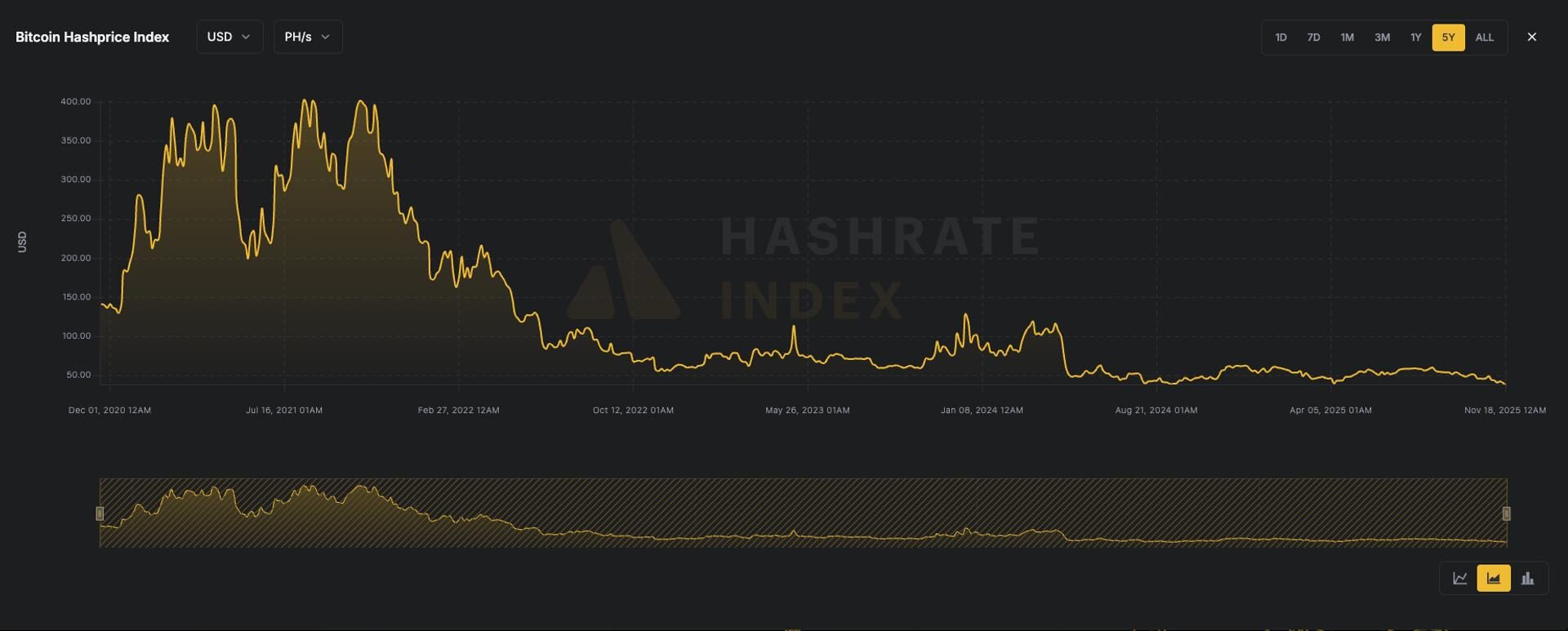BTC Hashprice Falls to Five-Year Low
Falling revenue and record difficulty could tighten the squeeze on bitcoin miners, though many are more driven by their AI infrastructure initiatives.
By James Van Straten, AI Boost|Edited by Stephen Alpher
Nov 18, 2025, 1:46 p.m.

- Bitcoin’s hashprice has dropped to $38.2 PH/s, its lowest level in over 5 years, as difficulty and hashrate sit near record highs and bitcoin’s price drops back to $90,000.
- Mining stocks have pulled back sharply, though in many cases the declines are more attributable to a decline in investor enthusiasm for AI infrastructure.
Bitcoin’s hashprice has fallen to its lowest level in five years, according to Luxor, now sitting at $38.2 PH/s. Hashprice, a term introduced by Luxor, measures the expected daily value of one terahash per second of computing power. The metric reflects how much revenue a miner can expect from a specific amount of hashrate. It can be denominated in any currency or asset, although it is typically shown in USD or BTC.
Hashprice depends on four key variables: network difficulty, the price of bitcoin, the block subsidy, and transaction fees. Hashprice rises with bitcoin’s price and fee volume, and falls as mining difficulty increases.
STORY CONTINUES BELOW
Bitcoin’s hashrate remains near record levels at more than 1.1 ZH/s on a seven day moving average. Meanwhile, the bitcoin price is at $91,000, down roughly 30% from its October all time high of more than $126,000, and network difficulty remains near all-time highs at 152 trillion (t). Transaction fees remain extremely low, with mempool.space quoting a high priority transaction at 25 cents or 2 sat/vB.
This decline in hashprice is occurring alongside a broader pullback in publicly traded bitcoin mining stocks, even as many in the sector have pivoted business plans away from BTC mining and to AI infrastructure.
The CoinShares mining ETF, WGMI, has fallen 43% from its peak and is trading just below $41.
AI Disclaimer: Parts of this article were generated with the assistance from AI tools and reviewed by our editorial team to ensure accuracy and adherence to our standards. For more information, see CoinDesk’s full AI Policy.
More For You
Nov 14, 2025

What to know:
- As of October 2025, GoPlus has generated $4.7M in total revenue across its product lines. The GoPlus App is the primary revenue driver, contributing $2.5M (approx. 53%), followed by the SafeToken Protocol at $1.7M.
- GoPlus Intelligence’s Token Security API averaged 717 million monthly calls year-to-date in 2025 , with a peak of nearly 1 billion calls in February 2025. Total blockchain-level requests, including transaction simulations, averaged an additional 350 million per month.
- Since its January 2025 launch , the $GPS token has registered over $5B in total spot volume and $10B in derivatives volume in 2025. Monthly spot volume peaked in March 2025 at over $1.1B , while derivatives volume peaked the same month at over $4B.
More For You
By Helene Braun|Edited by Sheldon Reback
41 minutes ago

The firm’s staking-enabled Solana fund debuts as inflows into early SOL products accelerate.
What to know:
- Fidelity is introducing the Fidelity Solana Fund (FSOL), adding a first staking-enabled crypto product to its lineup of exchange-traded funds.
- The move brings one of the largest asset managers into the small but growing Solana ETF market, which has only three spot products trading in the U.S.
- The launch lands as Canary Capital and VanEck roll out their own Solana ETFs and after Bitwise’s BSOL fund attracted $450 million in inflows since its debut.
-
Back to menu
Prices
-
Back to menu
-
Back to menu
Indices -
Back to menu
Research
-
Back to menu
Consensus 2026 -
Back to menu
Sponsored
-
Back to menu
Videos -
Back to menu
-
Back to menu
-
Back to menu
Webinars
Select Language











